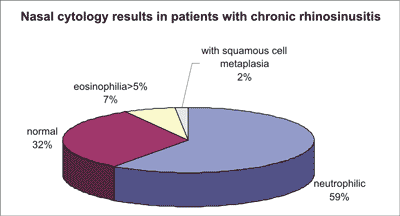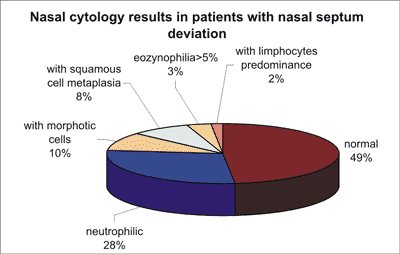© Borgis - New Medicine 4/2007, s. 100-101
*Eliza Brożek-Mądry, Mieczysław Chmielik
Nasal cytology in children with chronic rhinosinusitis or nasal septum deviation
Department of Pediatric Otolaryngology, Medical University of Warsaw, Poland
Head of Department: Prof. Mieczysław Chmielik, MD, PhD
Summary
Summary
Introduction. Nasal cytology enables to estimate the condition of nasal mucous membrane in patients with nasal pathology. The elements evaluated with this examination include epithelial cells and alluvial cells, such as lymphocytes and granulocytes.
Material and method a group of 30 children with chronic rhinosinusitis without polyps and 30 children with nasal septum deviation were included into the investigation. Patients had no symptoms of acute infection. Both groups had an exfoliative cytologic examination of mucosa and the specimen were obtained from the lower middle concha. Then the specimen were fixed with alcohol on the microscope slides and dyed with hematoxillin-eosyne. A microscopic evaluation of the cytograms was conducted by one person.
Results. The most common cytogram observed in chronic rhinosinusitis was neutrophilic one, while in nasal septum deviation it was normal. The specimen with presence of morphotic elements, such as red blood cells were observed only in patients with nasal septum deviation.
Conclusions. 1. inflammatory character of cytology in patients with chronic rhinosinusitis. 2. exposition to mucosal microdamage in patients with nasal septum deviation. 3. Non-invasiveness of cytologic examination. 4. differences in cytology between a group of children with CRS without polyps and a group of children with nasal septum deviation.
INTRODUCTION
Nasal cytology seems to be a valuable diagnostic tool but there is not much data in literature showing its results in nasal pathology. It is particularily important in children due to its painless and non-invasive character. As one of the parameters of respiratory mucous membrane it found its position in the diagnostics of allergic diseases. Normal nasal cytology presents mostly the columnar epithelial cells (picture 1) (1-4).

Pic. 1. Columnar epithelial cells of the normal mucous membrane with visible cilia
AIM
Estimation of nasal cytology usefulness in chronic rhinosinusitis (CRS) without polyps and nasal septum deviation in children.
MATERIAL AND METHOD
Thirty patients were collected in the group of children with CRS without polyps (15 females, 15 males) aged 5 to 17 years (mean age – 12 years) and thirty patients with nasal septum deviation (10males and 20 females) aged 8 to 17 years (mean age 14 years) in the period of two years between 2005 and 2007. Children included into the examined group had no ciliary dyskinesia measured with naso-ciliary clearance. All patients in the examined group had an exfoliative cytology taken from the inferior nasal concha. The material was then transferred on the microscope slides, fixed with 95% alcohol and dyed with hematoxillin-eosyne. Such prepared cytology was next evaluated under a biologic microscope Motic model 2820. This evaluation included the presence and count of epithelial cells such as columnar, squamous, basal and goblet cells and also alluvial cells such as neutrophils, limphocytes, eosinophils and monocytes.
RESULTS
The results obtained in this study are presented on two figures, one for the group of children with chronic rhinosinusitis and the other one for children with nasal septum deviation (fig.1 and 2).

Fig. 1. Characteristic of cytograms in children with chronic rhinosinusitis without polyps

Fig. 2. Characteristic of cytograms in children with nasal septum deviation
DISCUSSION
Comparing both figures we can say that the cytologic examination in children with chronic rhinosinusitis is more homogeneous and in most cases it is a neutrophilic cytogram (59%). Cytologic examination in patients with septum deviation is more differentiated with almost half normal cytograms (49%). Neutrophilic cytogram was observed twice more rarely tham in the group with CRS. Erytrocytes and squamous cell metaplasia were reported in 18% patients with nasal septum deviation and may show a larger predisposition in this group to some microdamage of the nasal mucous membrane. The possible explanation of the observed microdamages includes disturbed nasal air flow in patients with nasal septum deviation. There were eosinophilic cytograms in both groups with eosinophilia over 5% (3-7% patients). This presentation is a preliminary report. Publications on this problems in the medical literature was not found.
CONCLUSIONS
1. Cytologic examination in patients with chronic rhinosinusitis may stand for its inflammatory character.
2. Patients with nasal septum deviation are more exposed to the microdamages of the mucous membrane than patients with CRS, what can be confirmed by the presence of morphotic elements and squamous cell metaplasia in the cytograms.
3. Cytologic examination is non-invasive and allows us to evaluate the condition of the mucous membrane of the patients with CRS or nasal septum deviation not only in allergy diagnostics.
4. In the presented material there is a visible difference between a group of children with CRS without polyps and a group of children with septum deviation.
Piśmiennictwo
1. Tarchalska-Kryńska B: Cytologia błony śluzowej nosa. [W:] Alergiczne i niealergiczne nieżyty nosa. Łódź Mediton 2003; 146.2. Clement PAR, et al.: Management of rhinosinusitis in children. Consensus Meeting Brussels Belgium 1996 Arch. Otolaryngeal. Head. Neck Surg., 1998; 124: 31-35.3. Skoner DP: Allergic rhinitis definition, epidemiology, pathophysiology detection and diagnosis. J. Allergy Clin. Immunol., 108, supl. 52; 2001.4. Shapiro G.G.: Sinusitis and Allergy. In: Pediatric Sinusitis. Ed. Luck RP, New York Raven Press, 1992; 49.


